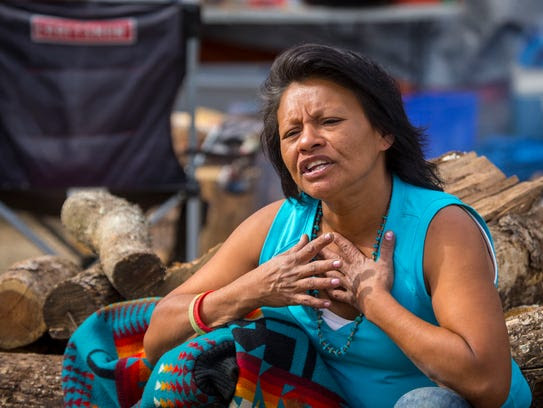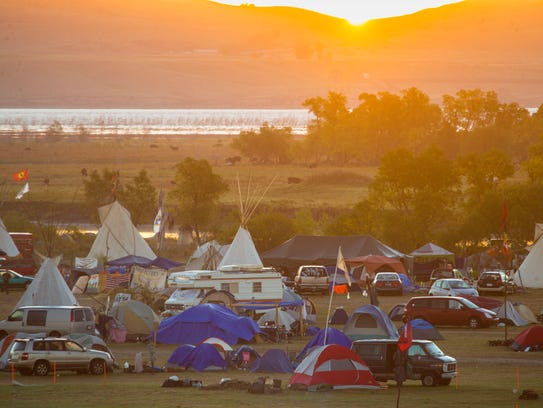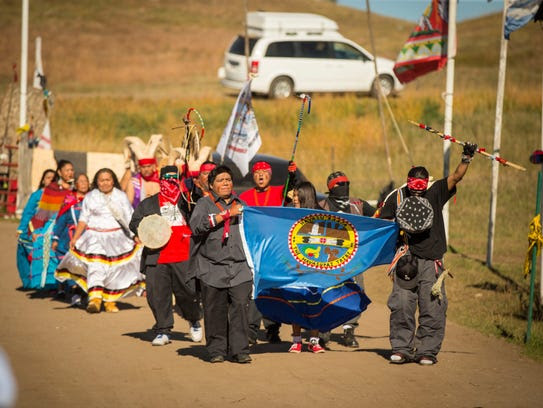Dear Friends,
I don’t believe I’ve ever included a mainstream media story in its entirety in this weekly update. Yet the story on the Standing Rock Sioux encampment in North Dakota by Des Moines Register reporter Kevin Hardy was so powerful — and the photos by Rodney White so compelling — that the piece warrants replication in its entirety. View the original article here or scroll down.
Thank you to our Native allies for their powerful witness against the Dakota Access pipeline. And thank you to the Iowa farmers, landowners and environmentalists who have been fighting the pipeline here for the past two years.
 We’re still fighting, and one thing you can do to help is “Vote for Bold” to receive CREDO Action funding to continue our work.
We’re still fighting, and one thing you can do to help is “Vote for Bold” to receive CREDO Action funding to continue our work.
And please check out this week’s Fallon Forum, with Dr. Charles Goldman and me analyzing Sunday’s presidential debate, including a guest appearance from Rev Billy, who performs at Trinity United Methodist Church in Des Moines on Wednesday.
Thanks!
Ed Fallon
Near Standing Rock, pipeline protest meets a spiritual movement
Kevin Hardy , kmhardy@dmreg.com

The Native Americans coming to the camp near Standing Rock Reservation have rekindled bonds among their tribes. The gathering is a peaceful protest of the Dakota Access pipeline construction.Rodney White/The Register

(Photo: Rodney White/The Register)
They’re gathered in a show of solidarity to oppose the nearby construction of the Dakota Access oil pipeline.
“If my mom was alive, she’d probably be right here,” said Two Shields, a 63-year-old member of the Standing Rock Sioux Tribe. “She told stories about this.”
To understand this sprawling tapestry of tents, teepees and campers, members of Sioux tribes point back to the tales and prophecies that their parents and grandparents passed on to them.
One foretold destruction: Specifically, a giant black snake would threaten Mother Earth.
Another was more hopeful: Black Elk, a holy man of the Oglala Lakota, prophesied that after generations of suffering, tribes of all bands would heal and unite as one.
“I’ve never seen anything like this,” said 46-year-old Melaine Stoneman, a member of the Sicangu Lakota tribe from South Dakota’s Rosebud Indian Reservation. “This is more than just protecting the land. This is a huge spiritual movement.”
Many native people interviewed here agreed, noting they believe this gathering is what a 9-year-old Black Elk envisioned nearly 150 years ago. To date, some 300 tribes and indigenous nations have staked their flags here.
The various camps here are home to many Sioux people occupying the U.S. Army Corps of Engineers land as a peaceful protest of the pipeline, which many view as the fulfilled prophecy of the black snake. They’ve been joined by Native Americans from Hawaii to Florida, indigenous people from across the globe and white allies.

All are opposed to the 1,172-mile oil pipeline, which is set to run from North Dakota to Illinois, cutting through Iowa along the way.
Members of newly arrived tribes continually parade into camp. They offer gifts and tell of their own battles at home fighting deforestation, mining and oil infrastructure projects. Their arrivals spark singing, dancing and praying.
Numbers change by the day, though camp leaders estimate the population here has swelled to as many as 7,000 campers in recent weeks, spawning a vibrancy not seen here for decades, Two Shields said.
In the 1960s, when the Corps dammed the nearby Missouri River, life on Standing Rock’s reservation changed when many native people were forced to relocate, she said. Members of the tribe say traditional spirituality waned. Poverty ravaged families, and children fled the reservation in all directions, Two Shields said.
Morning arrives at the Oceti Sakowin Camp near the Standing Rock reservation Thursday Sept. 29, 2016, near Cannon Ball, N.D. The Dakota Access pipeline passes less than two miles from the camp and will go under Lake Oahe in the background. (Photo: Rodney White/The Register)
“People should come and see how we live,” she said. “They put us on these reservations; it’s like living in a jail.”
Yet even as campers talk of poverty, drugs and alcohol devastating native families across the country, the mood in the main encampment is mostly uplifting. Aromas of burning cedar and sage mix with the overwhelming scent of glowing campfires.
“Once you’ve been there, it’s all you think about,” said Dawson Davenport, a 36-year-old University of Iowa student. Davenport, a member of the Meskwaki tribe in Tama, drove more than 10 hours to the North Dakota camp for a weekend in September.
The gathering was unlike anything he’s ever seen before. It hurt to leave.
“Some tribes didn’t get along for hundreds of years,” he said, “and they’re sitting next to each other having a cup of coffee and a cigarette, talking about life.”
***
Like all the elements, water is held sacred among native people. They talk of the amniotic fluid that begins life and the water that makes up most of the human body.
The pipeline is set to cross the Missouri River near Standing Rock’s reservation, where people rely on the river for drinking water. Many believe the pipeline will eventually break, threatening life along the river.
“We’re the voices speaking up for the four-legged brothers that can’t talk for themselves — all the animals down the river that can’t speak out,” said Douglas James, a 64-year-old member of the Lummi Nation. “We’re just speaking out for Mother Earth.”
Dakota Access counters that the state-of-the-art pipeline is being built to strict safety standards, and notes that state and federal authorities have permitted its construction.

Protesters of the Dakota Access pipeline have set up a camp near Standing Rock Reservation in North Dakota. Rodney White/The Register
Last week, a group of Lummi from Washington state visited the camp, bringing dozens of King salmon from the Pacific Ocean. After an introduction, they promptly dug a pit and built a fire. Over the flames, they roasted salmon fillets on ironwood fish sticks to feed the camp.
James said the movement has given voice to native people everywhere.
“No matter how bad you tried to annihilate the native people, we’re still here,” he said. “We still exist. We’re still the protectors of the Earth.”
Native culture is rich with stories of spirits cohabiting the Earth with humans.
A Havasupai medicine man who goes by only Uqualla said native spirituality is difficult for those in mainstream society to understand. Divinity is not reserved for the creator, but is shared among people, plants, animals and the elements.
Havasupai tribe medicine man Uqualla, shown at the Oceti Sakowin Camp near the Standing Rock reservation Saturday, Oct. 1, 2016, says: “We’re here basically to be sentinels for a force that is unseen.” (Photo: Rodney White/The Register)
“Many people fantasize and glorify this. And we’re not here as fantasy beings or glorified beings,” he said. “We’re here basically to be sentinels for a force that is unseen.”
He said spiritual forces in the camp are working to protect the Earth from what is viewed as an assault by the pipeline.
“We’re praying to the rising sun. We’re praying to the setting sun. We’re bringing in the sacred songs. We’re building the sacred fire,” said Uqualla, 63. “So what we’ve created here is a huge vortex of such intensity that is growing skyward.”
After growing up divorced from her Crow Creek Sioux heritage, Blue Star Woman said she reconnected with her roots in adulthood. The 48-year-old now lives on the tribe’s South Dakota reservation and has been learning both the language and the culture.
She grew up in the Wesleyan Church and compared the feelings of her newfound spiritual revelations to what born-again Christians feel in being saved by Jesus Christ.
“But 20 times greater,” she said, “because I felt that connection to Mother Earth.”
Life at the encampment has only deepened that connection. After taming a wild horse, she said elders dubbed her a woman warrior. Men who oversee the rite of the sacred pipe invited her into a sweat lodge ceremony, where she sang and prayed.
“I don’t know my language,” she said. “But I knew those ceremonial songs.”

Blue Star Woman, 48, of the Crow Creek Sioux explains how she reconnected with Mother Earth at the Oceti Sakowin Camp near the Standing Rock reservation Friday, Sept. 30, 2016. (Photo: Rodney White/The Register)
***
Life at the Oceti Sakowin Camp revolves around a central sacred fire, which is lined with canopies and folding camp chairs.
Here, many eat meals off paper plates from the adjacent volunteer kitchen.
Speakers standing on tripods and a large message board serve as the communication backbone in a place with meager cellular service.
It’s in this area where newly arrived tribes are formally introduced and welcomed.
On a recent weekday, about 20 Havasupai people sang and danced after driving from their reservation at the bottom of the Grand Canyon. They wore traditional attire. The women donned bright blue dresses and red shawls and decorated their hair with small woven baskets. The men went shirtless and were crowned with curling ram horns.
They sang a song about water to a low and steady drumbeat. The bells they wore rang out as they pounded their feet in toward the fire and out toward the circled crowd.
The Havasupai told of their own environmental battles protesting uranium mining in the Grand Canyon.
Representatives of the Havasupai Tribe from the Havasupai Indian Reservation in the Grand Canyon enter the Oceti Sakowin Camp near Standing Rock reservation Thursday, Sept. 29, 2016, near Cannon Ball, N.D. The Dakota Access pipeline passes less than two miles from the camp and will go under Lake Oahe and the Missouri River. (Photo: Rodney White/The Register)
“We are living under a demonic entity,” said Jahmisa Manakaja, 35. “And we have been asleep for a long, long time. And today we have awakened.”
She said she was called by the spirits, and the creator blessed the group’s trip.
“Many will come and go, but we’re all here in spirit,” she said. “We never left. We’ve never left this land.”
The next day, a group of three indigenous Sami people from Scandinavia arrived at the camp.
The women sat on their knees, and their bright crimson and blue skirts flowed in front of them. They offered Standing Rock’s chairman gifts, including reindeer hide and a traditional cup carved from birch. Onlookers stood silent as they cried out a yoik, a traditional song that combines deep guttural sounds with strikingly high notes.
Sofia Jannok, a Swedish singer, told how her people combat mining and struggle to maintain natural habitats for reindeer, which many rely upon for food, fur and livelihood. The Sami ancestral area spans parts of Norway, Sweden, Finland and Russia.
“We are one. We hear you, we see you,” she said. “And the fight you have is also the fight we have.”
Standing Rock Sioux Chairman Frank Archambault II, left, is given a gift by Sofia Jannok, center, Inger Berit Gaup and Sara Marielle Gail, right, representing the Sami indigenous of Northern Europe during a gathering in the main fire circle at Oceti Sakowin Camp near the Standing Rock reservation Friday, Sept. 30, 2016, near Cannon Ball, N.D. (Photo: Rodney White/The Register)
***
Outside the camp, winding two-lane roads frame vast expanses of browning sunflower fields and yellowing pasture. Small boulders and rocks pock the hilly terrain.
The federal government once considered this Sioux territory: It was included in the 1868 Treaty of Fort Laramie, which created the Great Sioux Reservation. But less than a decade later, Congress began to cede much of the territory back, including the gold-rich Black Hills, a move that the tribes here still contest.
Those longstanding grievances have fueled and helped define the pipeline protests, resurrecting for tribes the broken promises of the past.
The pipeline protest is “the most immediate concern,” said Walter Fleming, department head and professor of Native American studies at Montana State University. “But I think all tribes would be in agreement that this is a bigger question about tribes being able to assert their rights beyond the boundary of the reservation.”
Jahmisa Manakaja, 35, of the Havasupai Tribe from the Havasupai Indian Reservation in the Grand Canyon addresses the Oceti Sakowin Camp main fire ring Thursday, Sept. 29, 2016. (Photo: Rodney White/The Register)
Fleming, an enrolled member of the Kickapoo Tribe in Kansas, says this occupation is reminiscent of others:
In 1969, 89 Native American activists undertook a 19-month occupation of Alcatraz Island in an effort to reclaim native land.
In 1973, Oglala Lakota and American Indian Movement members occupied the site of the 1890 Wounded Knee massacre. The dispute started over a tribal leadership issue, but also tapped into the federal government’s failure to honor past treaties. The 71-day occupation ended after federal agents killed a Lakota man.
Fleming said both of those movements were more militant than the Standing Rock effort.
“This one is certainly the opposite,” he said. “It’s peaceful and prayerful.”
A barbed wire fence in front of the camp proclaims to drivers along state Highway 1806: “We are unarmed.”
The protesters here, who call themselves water protectors, maintain they have no plans to bring violence to their struggle.
“We’re here in prayer,” said Joel Running Bear. “We have no weapons.”
The U.S. Army Corps of Engineers, nodding to protesters’ First Amendment rights, has indicated it will not evict protesters from the campsite. But many fear that the other side is gearing up for a fight.
State troopers, Bureau of Indian Affairs police and city police officers from as far away as Fargo constantly buzz past the camp. The North Dakota National Guard checks license plates at a concrete road blockade nearly 30 miles north of the camp. And a non-law enforcement helicopter, rumored to be private security, frequently buzzes overhead.
North Dakota National Guardsmen control traffic Sunday, Oct. 2, 2016, just south of Mandan, N.D., on the road leading to a camp near Standing Rock reservation. They have been checking the license numbers of vehicles that head toward the reservation and Dakota Access pipeline work areas. (Photo: Rodney White/The Register)
Officials with the lead law enforcement agency, the Morton County Sheriff’s Department, could not be reached for comment.
But Lt. Tom Iverson, spokesman for the North Dakota State Highway Patrol, said on-scene officers want to avoid confrontation with protesters. While activists have not been violent, he said their actions were aggressive toward police. Just this week, he said several protesters who ventured off the campsite wore gas masks and approached police in an attempt to intimidate officers protecting work sites.
“It’s not peaceful,” he said. “It may be nonviolent, but some of the actions and tactics that are taken out there toward law enforcement, toward citizens and toward the state of North Dakota are not peaceful.”
Running Bear, a 32-year-old Standing Rock member, said native people have been praying since the days of Christopher Columbus. They prayed when they were moved onto reservations. And they prayed when native children were stripped of their culture in state-sponsored boarding schools.
“We prayed and prayed and prayed,” he said. “We’re still praying today.”
He wonders how another race would have responded to the centuries of degradation and death the U.S. government has perpetuated against generations of native people. And he worries that the government isn’t finished.
As much as he wants peace, he believes the conflict could escalate to violence.
“On their side, yeah,” he said. “But I believe that they’ve been waiting since Custer to do this.”
International Indigenous Youth Council of Standing Rock and Oceti Sakowin Youth encampment teepee at the Oceti Sakowin Camp near Standing Rock reservation Saturday Oct. 1, 2016, near Cannon Ball, N.D. The Dakota Access pipeline passes less than two miles from the camp and will go under Lake Oahe and the Missouri River. (Photo: Rodney White/The Register)
***
In the daylight, campers occupy themselves with the mundane tasks of daily living. They chop firewood, wash their clothes in buckets and groom the many horses corralled in temporary confinements.
Oceti Sakowin began as an overflow camp for other nearby camps that formed early in the spring. Named for the seven bands that historically made up the Great Sioux Nation, it now serves as the heart of the resistance.
Every now and then, groups will trek to pray and sing near pipeline construction, and some risk arrest by venturing onto work sites. So far, more than 90 people have been arrested.
But more often, the camp is home to quieter shows of strength.
On a recent Saturday evening, Chet Stoneman prepared for an all-night peyote ceremony on the far edge of the camp.
Chet Stoneman, 62, far right, of the Rosebud Indian Reservation in South Dakota guides the assembly of a teepee for a peyote ceremony at the Oceti Sakowin Camp Saturday, Oct. 1, 2016. (Photo: Rodney White/The Register)
Friends and relatives carefully raked the dirt inside his 28-foot-wide teepee as others gathered wild sage from the nearby hillsides. Such ceremonies, along with other sacred rituals like the use of sweat lodges, are all working to combat the pipeline, he said.
“This is how much of the indigenous people care about our Mother Earth,” he said.
Gerald Iron Shield, a Standing Rock member, drives to the camp most weeknights after he completes his workday at the tribe’s diabetes program. He finds peace and healing at the encampment.
Over the years, many native people seemed to lose their connections with traditional spiritual teachings, Iron Shield said. Mainline Christian churches planted roots on the reservation. Ancient traditions fell out of favor.
Now he sees a revival playing out before him.
“It’s our people coming back home,” he said. “It’s been prophesied that this time in our life is coming. There should be healing coming next.”
Gerald Iron Shield, 62, of the Standing Rock Sioux talks at the Oceti Sakowin Camp near the Standing Rock reservation Thursday, Sept. 29, 2016. (Photo: Rodney White/The Register)









